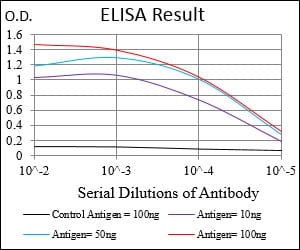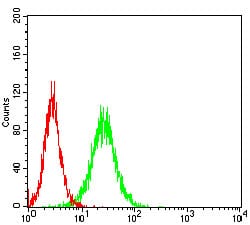

| WB | 咨询技术 | Human,Mouse,Rat |
| IF | 咨询技术 | Human,Mouse,Rat |
| IHC | 咨询技术 | Human,Mouse,Rat |
| ICC | 技术咨询 | Human,Mouse,Rat |
| FCM | 1/200 - 1/400 | Human,Mouse,Rat |
| Elisa | 1/10000 | Human,Mouse,Rat |
| Aliases | Rb2; P130 |
| Entrez GeneID | 5934 |
| clone | 2C8A8 |
| WB Predicted band size | 128.4kDa |
| Host/Isotype | Mouse IgG1 |
| Antibody Type | Primary antibody |
| Storage | Store at 4°C short term. Aliquot and store at -20°C long term. Avoid freeze/thaw cycles. |
| Species Reactivity | Human |
| Immunogen | Purified recombinant fragment of human RBL2 (AA: 939-1139) expressed in E. Coli. |
| Formulation | Purified antibody in PBS with 0.05% sodium azide. |
+ +
以下是关于RBL2抗体的3篇参考文献及其摘要概括:
1. **文献名称**:*RBL2/p130 is a critical mediator of cell cycle exit and differentiation in myoblasts*
**作者**:Claudio PP, et al. (2001)
**摘要**:研究利用RBL2特异性抗体,通过免疫沉淀和Western blot分析,发现RBL2/p130在成肌细胞分化过程中通过调控E2F4复合物促进细胞周期退出,揭示了其在肌肉发育中的关键作用。
2. **文献名称**:*Role of p130 in cellular senescence and cancer*
**作者**:Susaki E, Nakayama KI (2007)
**摘要**:文章通过免疫组化及抗体阻断实验,证实RBL2/p130在衰老细胞中高表达,并参与抑制癌基因诱导的细胞增殖,为RBL2在肿瘤抑制中的功能提供了实验证据。
3. **文献名称**:*RBL2/p130 coordinates epigenetic silencing of oncogenes in neural stem cells*
**作者**:Tedesco D, et al. (2002)
**摘要**:该研究使用RBL2抗体进行ChIP-seq和共聚焦显微术,发现RBL2通过招募组蛋白修饰酶沉默神经干细胞中的促癌基因,维持干细胞的稳态。
4. **文献名称**:*RBL2 expression correlates with neuroblastoma differentiation status*
**作者**:Canepa ET, et al. (2004)
**摘要**:通过免疫印迹和流式细胞术结合RBL2抗体,研究发现神经母细胞瘤分化过程中RBL2表达显著上调,提示其作为分化标志物的潜在临床价值。
这些文献均涉及RBL2抗体的实验应用(如蛋白检测、定位分析或功能研究),并聚焦于RBL2在细胞周期、分化及疾病中的作用。
The retinoblastoma-like protein 2 (RBL2), also known as p130. is a member of the retinoblastoma (Rb) tumor suppressor protein family, which includes Rb1 (p105) and RBL1 (p107). RBL2 plays a critical role in cell cycle regulation by inhibiting E2F transcription factors, thereby preventing G1-to-S phase progression. It is predominantly expressed in quiescent or differentiated cells and interacts with cyclin-dependent kinases (CDKs) and viral oncoproteins, linking it to cancer development and cellular senescence. Dysregulation of RBL2 is associated with various cancers, neurodegenerative disorders, and abnormal developmental processes.
Antibodies targeting RBL2 are essential tools for studying its expression, localization, and functional interactions in both physiological and pathological contexts. These antibodies are widely used in techniques such as Western blotting, immunohistochemistry (IHC), immunofluorescence (IF), and co-immunoprecipitation (Co-IP) to investigate RBL2's role in cell cycle control, tumor suppression, and response to therapeutic agents. Polyclonal and monoclonal RBL2 antibodies are available, often raised in rabbits or mice using immunogenic peptide sequences specific to conserved regions of the protein. Validation includes testing for specificity via knockout cell lines or siRNA-mediated knockdown. Researchers rely on these antibodies to explore RBL2's involvement in diseases and its potential as a biomarker or therapeutic target.
×